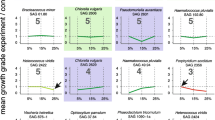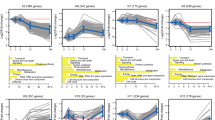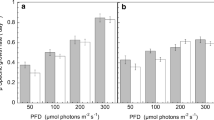Abstract
Carbon concentrating mechanisms (CCMs) are common among microalgae, but their regulation and even existence in some of the most promising biofuel production strains is poorly understood. This is partly because screening for new strains does not commonly include assessment of CCM function or regulation despite its fundamental role in primary carbon metabolism. In addition, the inducible nature of many microalgal CCMs means that environmental conditions should be considered when assessing CCM function and its potential impact on biofuels. In this study, we address the effect of environmental conditions by combining novel, high frequency, on-line 13CO2 gas exchange screen with microscope-based lipid characterization to assess CCM function in Nannochloropsis salina and its interaction with lipid production. Regulation of CCM function was explored by changing the concentration of CO2 provided to continuous cultures in airlift bioreactors where cell density was kept constant across conditions by controlling the rate of media supply. Our isotopic gas exchange results were consistent with N. salina having an inducible “pump-leak” style CCM similar to that of Nannochloropsis gaditana. Though cells grew faster at high CO2 and had higher rates of net CO2 uptake, we did not observe significant differences in lipid content between conditions. Since the rate of CO2 supply was much higher for the high CO2 conditions, we calculated that growing cells bubbled with low CO2 is about 40 % more efficient for carbon capture than bubbling with high CO2. We attribute this higher efficiency to the activity of a CCM under low CO2 conditions.










Similar content being viewed by others
References
Badger MR (1985) Photosynthetic oxygen exchange. Annu Rev Plant Physiol 36:27–53
Badger MR (2003) CO2 concentrating mechanisms in cyanobacteria: molecular components, their diversity and evolution. J Exp Bot 54:609–622
Badger MR, Kaplan A, Berry JA (1980) The internal inorganic C pool of Chlamydomonas reinhardtii: evidence for a CO2 concentrating mechanism. Plant Physiol 66:407–413
Badger MR, Andrews TJ, Whitney SM, Ludwig M, Yellowlees DC, Leggat W, Price GD (1998) The diversity and coevolution of Rubisco, plastids, pyrenoids, and chloroplast-based CO2-concentrating mechanisms in algae. Can J Bot 76:1052–1071
Badger MR, Hanson DT, Price GD (2002) Evolution and diversity of CO2 concentrating mechanisms in cyanobacteria. Funct Plant Biol 29:161–173
Barbour MM, McDowell NG, Tcherkez G, Bickford CP, Hanson DT (2007) A new measurement technique reveals rapid post-illumination changes in the carbon isotope composition of leaf-respired CO2. Plant Cell Environ 30:469–482
Beardall J, Giordano M (2002) Ecological implications of microalgal and cyanobacterial CO2 concentrating mechanisms, and their regulation. Funct Plant Biol 29:335–347
Beardall J, Roberts S, Raven J (2005) Regulation of inorganic carbon acquisition by phosphorus limitation in the green alga Chlorella emersonii. Can J Bot 83:859–864
Becker EW (1994) Microalgae: biotechnology and microbiology. Cambridge University Press, Cambridge
Blankenship RE, Tiede DM, Barber J, Brudvig GW, Fleming G, Ghirardi M, Gunner MR, Junge W, Kramer DM, Melis A, Moore TA, Moser CC, Nocera DG, Nozik AJ, Ort DR, Parson WW, Prince RC, Sayre RT (2011) Comparing photosynthetic and photovoltaic efficiencies and recognizing the potential for improvement. Science 332:805–809
Brueggeman AJ, Gangadharaiah DS, Cserhati MF, Casero D, Weeks DP, Ladunga I (2012) Activation of the carbon concentrating mechanism by CO2 deprivation coincides with massive transcriptional restructuring in Chlamydomonas reinhardtii. Plant Cell 24:1860–1875
Chiu S-Y, Kao C-Y, Tsai M-T, Ong S-C, Chen C-H, Lin C-S (2009) Lipid accumulation and CO2 utilization of Nannochloropsis oculata in response to CO2 aeration. Bioresour Technol 100:833–838
Collins AM, Jones HDT, Han D, Hu Q, Beechem TE, Timlin JA (2011) Carotenoid distribution in living cells of Haematococcus pluvialis (Chlorophyceae). PLoS ONE 6:e24302
Collins AM, Liberton M, Jones HDT, Garcia OF, Pakrasi HB, Timlin JA (2012) Photosynthetic pigment localization and thylakoid membrane morphology are altered in Synechocystis 6803 phycobilisome mutants. Plant Physiol 158:1600–1609
Da Rosa APC, Carvalho LF, Goldbeck L, Costa JAV (2011) Carbon dioxide fixation by microalgae cultivated in open bioreactors. Energy Convers Manag 52:3071–3073
Davis R, Jones H, Collins A, Ricken J, Sinclair M, Timlin J, Singh S (2013) Label-free measurement of aalgal triacylglyceride production using fluorescence hyperspectral imaging. Algal Res. doi:10.1016/j.algal.2013.11.010
DeLong JP, Hanson DT (2009a) Metabolic rate links density to demography in Tetrahymena pyriformis. ISME J 3:1396–1401
DeLong JP, Hanson DT (2009b) Density-dependent individual and population-level metabolic rates in a suite of single-celled eukaryotes. Open Biol J 2:32–37
Evans JR, Sharkey TD, Berry JA, Farquhar GD (1986) Carbon isotope discrimination measured concurrently with gas exchange to investigate CO2 diffusion in leaves of higher plants. Aust J Plant Physiol 13:281–292
Farquhar GD (1983) On the nature of carbon isotope discrimination in C4 species. Aust J Plant Physiol 10:205–226
Flexas J, Ribas-Carbó M, Hanson DT, Bota J, Otto B, Cifre J, McDowell N, Medrano H, Kaldenhoff R (2006) Tobacco aquaporin NtAQP1 is involved in mesophyll conductance to CO2 in vivo. Plant J 48:427–439
Fukuzawa H, Miura K, Ishizaki K, Kucho K, Saito T, Kohinata T (2001) Ccm1, a regulatory gene controlling the induction of a carbon-concentrating mechanism in Chlamydomonas reinhardtii by sensing CO2 availability. Proc Natl Acad Sci USA 98:5347–5352
Genty B, Briantais JM, Baker NR (1989) The relationship between the quantum yield of photosynthetic electron transport and quenching of chlorophyll fluorescence. Biochim Biophys Acta 900:87–92
Graham LE, Graham JM, Wilcox LW (2009) Algae. Benjamin Cummings/Pearson, San Francisco
Huertas E, Montero O, Lubia LM (2000) Effects of dissolved inorganic carbon availability on growth, nutrient uptake and chlorophyll fluorescence of two species of marine microalgae. Aquac Eng 22:181–197
Huertas IE, Colman B, Espie GS (2002a) Mitochondrial-driven bicarbonate transport supports photosynthesis in a marine microalga. Plant Physiol 130:284–291
Huertas IE, Colman B, Espie GS (2002b) Inorganic carbon acquisition and its energization in eustigmatophyte algae. Funct Plant Biol 29:271–277
Huppe HC, Turpin DH (1994) Integration of carbon and nitrogen metabolism in plant and algal cells. Annu Rev Plant Physiol Plant Mol Biol 45:577–607
James SC, Boriah V (2010) Modeling algae growth in an open-channel raceway. J Comput Biol 17:895–906
James SC, Janardhanam V, Hanson DT (2013) Simulating pH effects in an algal-growth hydrodynamics model. J Phycol 49:608–615
Jones HDT, Haaland DM, Sinclair MB, Melgaard DK, Collins AM, Timlin JA (2012) Preprocessing strategies to improve MCR analyses of hyperspectral images. Chemom Intell Lab Syst 117:149–158
Kaplan A, Reinhold L (1999) CO2 concentrating mechanisms in photosynthetic microorganisms. Annu Rev Plant Physiol Plant Mol Biol 50:539–570
Li Q, Canvin D (1998) Energy sources for HCO -3 and CO2 transport in air-grown cells of synechococcus UTEX 625. Plant Physiol 116:1125–1132
McCue MD, Amaya JA, Yang AS, Erhardt EB, Wolf BO, Hanson DT (2013) Targeted 13C enrichment of lipid and protein pools in the body reveals circadian changes in oxidative fuel mixture during prolonged fasting: a case study using Japanese quail. Comp. Biochem. Physiol. B 166(4):546–554
McNevin DB, Badger MR, Whitney SM, von Caemmerer S, Tcherkez GGB, Farquhar GD (2007) Differences in carbon isotope discrimination of three variants of D-ribulose-1,5-bisphosphate carboxylase/oxygenase reflect differences in their catalytic mechanisms. J Biol Chem 282:36068–36076
Merrett MJ, Nimer NA, Dong LF (1996) The utilization of bicarbonate ions by the marine microaiga Nannochloropsis oculata (Droop) Hibberd. Plant Cell Environ 19:478–484
Mook WG, Bommerson JC, Staverman WH (1974) Carbon isotope fractionation between dissolved bicarbonate and gaseous carbon dioxide. Earth Planet Sci Lett 22:169–176
Munoz J, Merrett MJ (1989) Inorganic-carbon transport in some marine eukaryotic microalgae. Planta 178:450–455
National Research Council (2012) Sustainable development of algal biofuels in the United States. The National Academies Press, Washington
Ort DR, Melis A (2011) Optimizing antenna size to maximize photosynthetic efficiency. Plant Physiol 155:79–85
Ota M, Kato Y, Watanabe H, Watanabe M, Sato Y, Smith RL, Inomata H (2009) Effect of inorganic carbon on photoautotrophic growth of microalga Chlorococcum littorale. Biotechnol Prog. 25(2):492–498
Palmqvist K, Yu J, Badger MR (1994) Carbonic anhydrase activity and inorganic carbon fluxes in low- and high-Ci cells of Chlamydomonas reinhardtii and Scenedesmus obliquus. Physologia Plant 90:537–547
Pate R, Klise G, Wu B (2011) Resource demand implications for US algae biofuels production scale-up. Appl Energy 88:3377–3388
Porra RJ, Thompson WA, Kriedemann PE (1989) Determination of accurate extinction coefficients and simultaneous equations for assaying chlorophylls a and b extracted with four different solvents: verification of the concentration of chlorophyll standards by atomic absorption spectroscopy. Biochim Biophys Acta 975:384–394
Pragya N, Pandey KK, Sahoo PK (2013) A review on harvesting, oil extraction and biofuels production technologies from microalgae. Renew Sustain Energy Rev 24:159–171
Raven JA (2003) Inorganic carbon concentrating mechanisms in relation to the biology of algae. Photosynth Res 77:155–171
Raven JA (2010) Inorganic carbon acquisition by eukaryotic algae: four current questions. Photosynth Res 106:123–134
Raven JA, Beardall J (2003) Carbon acquisition mechanism of algae: carbon dioxide diffusion and carbon dioxide concentrating mechanisms. In: Larkum AWD, Douglas SE, Raven JA (eds) Photosynth algae. Springer, Dordrecht, pp 225–244
Raven JA, Ball LA, Beardall J, Giordano M, Maberly SC (2005) Algae lacking carbon-concentrating mechanisms. Can J Bot 83:879–890
Raven JA, Cockell CA, de La Rocha C (2008) The evolution of inorganic carbon concentrating mechanisms in photosynthesis. Proc R Soc Biol Sci Ser B 363:2641–2650
Reinfelder JR (2011) Carbon concentrating mechanisms in eukaryotic marine phytoplankton. Ann Rev Mar Sci 3:291–315
Sharkey TD, Berry JA (1985) Carbon isotope fractionation of algae as influenced by an inducible CO2 concentrating mechanism. In: Berry JA, Lucas WJ (eds) Org. carbon uptake by Aquat. Photosynth. Org. American Society of Plant Physiologists, Rockville, pp 389–401
Sinclair MB, Haaland DM, Timlin JA, Jones HDT (2006) Hyperspectral confocal microscope. Appl Opt 45:6283–6291
Spalding MH (2008) Microalgal carbon-dioxide-concentrating mechanisms: Chlamydomonas inorganic carbon transporters. J Exp Bot 59:1463–1473
Sueoka N (1960) Mitotic replication of deoxyribonucleic acid in Chlamydomonas reinhardtii. Proc Natl Acad Sci USA 46:565–569
Sukenik A, Tchernov D, Kaplan A, Huertas E, Lubian LM, Livne A (1997) Uptake, efflux, and photosynthetic utilization of inorganic carbon by the marine Eustigmatophyte Nannochloropsis sp. J Phycol 33:969–974
Sukenik A, Beardall J, Kromkamp J, Kopecký J, Masojídek J, van Bergeijk S, Gabai S, Shaham E, Yamshon A (2009) Photosynthetic performance of outdoor Nannochloropsis mass cultures under a wide range of environmental conditions. Aquat Microb Ecol 56:297–308
Sültemeyer D, Biehler K, Fock H (1993) Evidence for the contribution of pseudocyclic photophosphorylation to the energy requirement of the mechanism for concentrating inorganic carbon in Chlamydomonas. Planta 189:235–242
Tchernov D, Livne A, Kaplan A, Sukenik A (2008) The kinetic properties of ribulose-1,5-bisphosphate carboxylase/oxygenase may explain the high apparent photosynthetic affinity of Nannochloropsis sp. to ambient inorganic carbon. Isr J Plant Sci 56:37–44
Van Wagenen J, Miller TW, Hobbs S, Hook P, Crowe B, Huesemann M (2012) Effects of light and temperature on fatty acid production in Nannochloropsis salina. Energies 5:731–740
Vance P, Spalding MH (2005) Growth, photosynthesis, and gene expression in Chlamydomonas over a range of CO2 concentrations and CO2/O2 ratios : CO2 regulates multiple acclimation states. Can J Bot 809:796–809
Williams PJLB, Laurens LML (2010) Microalgae as biodiesel & biomass feedstocks: Review & analysis of the biochemistry, energetics & economics. Energy Environ Sci 3:554–590
Yamano T, Miura K, Fukuzawa H (2008) Expression analysis of genes associated with the induction of the carbon-concentrating mechanism in Chlamydomonas reinhardtii. Plant Physiol 147:340–354
Yue L, Chen W (2005) Isolation and determination of cultural characteristics of a new highly CO2 tolerant fresh water microalgae. Energy Convers Manag 46:1868–1876
Acknowledgments
The authors are grateful to Dr. Michael B. Sinclair for the use and maintenance of the hyperspectral confocal fluorescence microscope and Dr. Bryan D. Carson for the use of the flow cytometer. Majority support for this research was from the Laboratory Directed Research and Development Program at Sandia National Laboratories (JAT, AMC, HDTJ, JR and DTH). Sandia National Laboratories is a multi-program laboratory managed and operated by Sandia Corporation, a wholly owned subsidiary of Lockheed Martin Corporation, for the U.S. Department of Energy’s National Nuclear Security Administration under contract DE-AC04-94AL85000. This work was also partially supported by the National Science Foundation Award # IOS 0719118 (SLN, DTH) and the EPSCoR Program under Award # IIA-1301346 (New Mexico). Any opinions, findings, and conclusions or recommendations expressed in this material are those of the author(s) and do not necessarily reflect the views of the National Science Foundation. This manuscript has been authored by Sandia Corporation under Contract No. DE-AC04-94AL85000 with the U.S. Department of Energy. The United States Government retains and the publisher, by accepting the article for publication, acknowledges that the United States Government retains a non-exclusive, paid-up, irrevocable, world-wide license to publish or reproduce the published form of this manuscript, or allow others to do so, for United States Government purposes.
Author information
Authors and Affiliations
Corresponding author
Rights and permissions
About this article
Cite this article
Hanson, D.T., Collins, A.M., Jones, H.D.T. et al. On-line stable isotope gas exchange reveals an inducible but leaky carbon concentrating mechanism in Nannochloropsis salina . Photosynth Res 121, 311–322 (2014). https://doi.org/10.1007/s11120-014-0001-0
Received:
Accepted:
Published:
Issue Date:
DOI: https://doi.org/10.1007/s11120-014-0001-0




